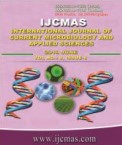


 National Academy of Agricultural Sciences (NAAS)
National Academy of Agricultural Sciences (NAAS)

|
PRINT ISSN : 2319-7692
Online ISSN : 2319-7706 Issues : 12 per year Publisher : Excellent Publishers Email : editorijcmas@gmail.com / submit@ijcmas.com Editor-in-chief: Dr.M.Prakash Index Copernicus ICV 2018: 95.39 NAAS RATING 2020: 5.38 |
An experiment was conducted at Agronomy farm, S.K.N. College of Agriculture, Jobner during kharif season 2017. The treatments comprising four Sulphur levels (control, 20 kg S/ha, 40 kg S/ha and 60 kg S/ha) and four foliar spray of iron (control, foliar spray of 0.5% FeSO4 at flowering, peg formation and flowering + peg formation) assigned to main and subplots of Randomized Block Design, respectively were replicated thrice. Groundnut variety RG-425(Raj Durga) was used as a test crop. Sulphur fertilization 60 kg/ha significantly increased chlorophyll and leghaemoglobin content but enzymatic activities in soil were found significant at 40 kg S/ha. Soil properties like Available S increases up to 60 kg/ha, but Available N, P, K and Fe did not differ significantly on application of different levels of Sulphur. The foliar spray of 0.5% at flowering + peg formation stage increases chlorophyll and leghaemoglobin content. The available N, P, K, S and Fe in soil as well as dehydrogenase and alkaline phosphates were found non-significant on foliar spray of 0.5% FeSO4 at different stages. Based on response studies, 60.19 kg/ha was found to be the optimum level of S for groundnut.
 |
 |
 |
 |
 |